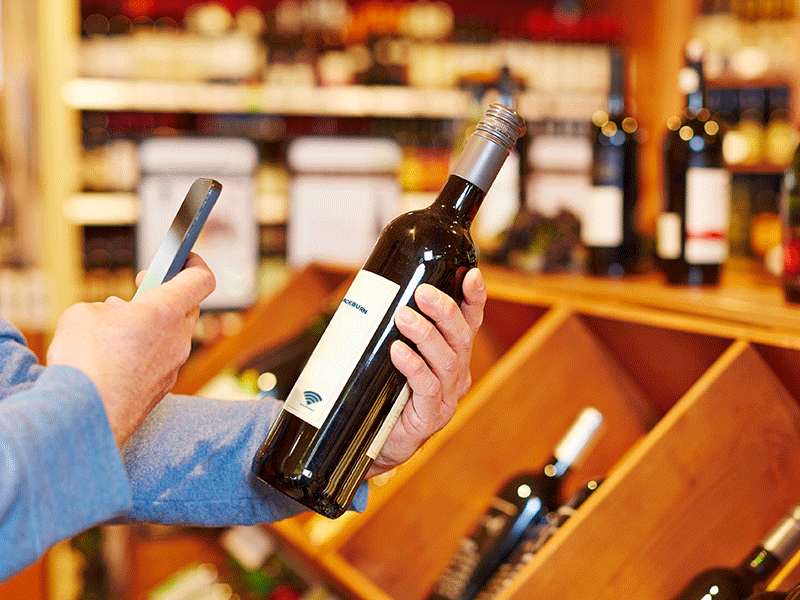
Authentication and social engagement are perhaps two of the strongest business cases for wine and spirits brands to adopt NFC smart labeling technology. Marsha Frydrychowski of Resource Label Group delves into how NFC technology is disrupting the way consumers interact with brands and what wine brands can do to adopt the technology and use it to their advantage.
By 2024, the global near field communication (NFC) market will nearly triple as adoption of the technology grows. And the latest generation of iPhones can read NFC tags without the use of a third-party app. All of this means the average smartphone-carrying consumer will not only be familiar with NFC, but will be able to tap their device to an NFC label on your bottle and access any verification or promotional material programmed into the tag.
This NFC technology boom is already disrupting the way consumers interact with brands — consumers prefer using NFC tags to QR codes two to one, according to a study by Strategy Analytics. Wine and spirits brands who adapt to consumers’ preference for mobile technologies now will get ahead of their slow-to-change competitors and establish themselves as innovators in the industry.
Here we’ll examine two of the strongest business cases for wine and spirits brands to adopt NFC smart labeling technology: Authentication and social engagement.
Authenticity of high-value wine and spirits products
Counterfeit wine is pervasive — with an estimated $3 billion market. And for every dollar of fake wine sold, premium wine brands are losing business. Consider the 2012 case of wine collector Rudy Kurniawan, who mixed and sold fraudulent bottles of vintage wine. As much as $550 million in counterfeit wine he sold is still on the market today.
And while there’s no single layer solution to this widespread problem, smart labeling technology is proving promising as a way for premium wine customers to authenticate the provenance of the wine they purchase.
Each NFC tag has a semi-conductor with a unique identification number, allowing wine brands to program item-specific information into each wine label which is encrypted and far more difficult to replicate than a UPC code. When combined with other anti-fraud precautions, NFC tagging allows premium wine brands to prevent counterfeiting and premium wine customers to be confident in every purchase.
For wines in the $150-and-up price category, the cost of the NFC tag is inconsequential when compared the added value of brand protection, consumer trust and fraud prevention. And with a study reporting 75% of wine customers are more likely to purchase from a brand if they use anti-fraud technology, incorporating NFC tags into your product labels could contribute to sales uplift.
Drive social engagement before, during and after the sale
Authentication is a built-in feature of any NFC label — and due to the large memory capabilities of NFC tags, that same tag can be used to provide any other product-specific information you’d like to put in front of your consumers (e.g., the origin story of the wine, food pairing ideas, ideal serving temperature, branded video content).
The potential for social engagement is where smart labeling technology gets exciting for brand owners. Each NFC tag is a blank page ready to be programmed with content to achieve any branding, awareness or loyalty goal. And the potential for social engagement with NFC extends far beyond product labels.
Let’s say you’re a Napa Valley winery with tourists flooding into your tasting room every day. But each of those tourists is also visiting 15 other wineries as part of their tour. You want these tourists to remember and purchase your wines after their trip. To differentiate yourself, you could provide an NFC-enabled coaster or other keepsake for your customers to take home.
With a tap of their phone, past customers can access videos of your winemakers describing the wine. Just like that, you’ve allowed each person who walks into your tasting room to bring the experience of their winery visit home with them. And you can continually change the content in the cloud, allowing that same customer to have a different experience every time they scan the NFC tag.
And that’s just one example of the limitless potential of NFC tags to drive customer loyalty and engagement. You could use tamper-evident NFC labels to present different promotional messages before and after the bottle’s been open. You could combine the power of NFC technology and augmented reality (AR) to vary your marketing message depending on a customer’s mood. Practically any promotional campaign you can dream of, NFC can bring to life.
Now is the time for wine and spirits brands to make sure they understand how they can leverage NFC. Deploying a well-crafted NFC solution takes time. Brands that don’t start experimenting today will be hard-pressed to catch up to their early-adopting competitors. And unless consumers all stop using their cell phones, brands have no choice but to have a strong mobile strategy in place ready to launch.
For wine and spirits brands looking to experiment with NFC, reaching out to your label converter is a good place to start. Label converters will lead the charge for integrating NFC tags into product labels and other printable goods (e.g., coasters, posters, temporary tattoos), with other third parties offering their expertise for the promotional, software and infrastructure pieces of the NFC puzzle.




















